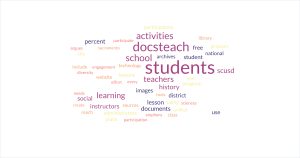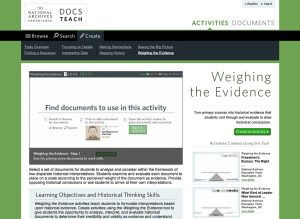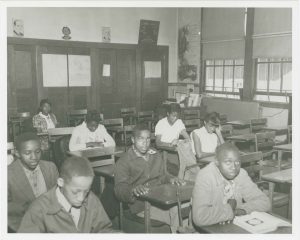Introduction
DocsTeach is a free service offered by the National Archives to provide instructors with public domain images and activities for students to expand upon learned experiences and course instruction. Students using these tools will be provided the opportunity to contextualize historical events and instructors can help students see themselves, family members, and ancestors in these complicated and historically significant images.
DocsTeach provides structured age-appropriate activities, or the opportunity to create activities, that involve the student directly in making observations and document analysis. “These participatory spaces are where learning will occur. Understanding and empathy among cross-cultural partners in a technological environment is the key to success,” argues Michael Stephens (2016). Libraries (and schools) need to “change the way they craft their services and tools so that users (students) have a clear and open avenue on which to communicate and participate,” argues Casey and Savastinuk in Library 2.0 (2007).
This unique program would serve Sacramento City Unified School District well in that instructors can curate the activities to serve the diverse student population of SCUSD. In an effort to produce “globally competitive life-long learners” as the district’s mission statement purports, the district and its educators should make every effort to include the student in the learning process. Students are accustomed to participatory media such as TikTok and Instagram. Why not allow students to be more active participants in their lessons?
Goals and Objectives
- Empower students to take control of their own learning in the social sciences
- Tailor learning to meet the specific cultural and demographic needs of the class
- Provide a welcoming and respectful environment by using images and documents that better represent the diversity of the SCUSD student body
- Foster debate and engagement with thought-provoking digital images
- Promote participation learning through visual and written student evaluations

Action Brief
Convince: Sacramento City Unified School District administrators, elementary school teachers, and social sciences teachers
That by: including the National Archives DocsTeach program into their history and social science curriculum and/or part of their school library visits
They will: encourage their students to ask questions, discover evidence, and participate in debates over the interpretation of what they see in the DocsTeach images
Which will: promote engagement with history and encourage students to offer their own perspective of history, which will make history lessons easier to digest, especially if the instructor chooses an example that a majority of students will find relatable
Because: the mission statement as a district aims for students to “graduate as globally competitive life-long learners, prepared to succeed in a career and higher education institution of their choice to secure gainful employment and contribute to society” (SCUSD, 2024)
And because: Sac Unified students represent the diversity of the city with the student population being 40 percent Hispanic or Latino; 17 percent Asian; 14 percent African American; and 18 percent white. About 7 percent of students are of two or more races or ethnicities. Residents within SCUSD speak more than 51 languages (SCUSD, 2024). Instructors and administrators should have this diversity at the front of their minds as they develop lesson plans that are engaging and participatory.

Who will DocsTeach help?
All SCUSD students will benefit from this participatory learning available through DocsTeach. Teachers will be able to use activities designed around a certain image or create their own activities using an outside source more relatable to their students. In this manner, teachers will be able to tailor the participatory lesson to that particular class. A social sciences teacher may have one period in which 70 percent of the class is Hmong and another period in which 60 percent is black. Instead of a “one-lesson-fits-all” approach, students can analyze, debate, and participate in activities provided by DocsTeach that are specific to their information needs and feel represented in the lesson of the day. Even if the image chosen for this activity is not reflective of all students in this class, all students and teachers will benefit from learning more about another culture’s traditions and history within the context of the course.
In a piece about the required teaching of our country’s founding documents, Jenny Sweeney writes, “The National Archives has a treasure trove of materials related to the Constitution and its amendments” (2019). She goes on to explain how these tools are especially handy for designing lesson plans and ideal for remote learning.
Inspiration
DocsTeach takes students out of the textbooks and into a world they can magnify and scrutinize. As free members, instructors will have access to more than 1,800 activities and 12,529 primary sources. The technology is here for students to engage with their teachers through the activities and give their opinions about what they see before them on the screen. These activities will make students feel important. Stephens writes in the Heart of Librarianship, “Technology extends human reach but participation requires engaged participants who feel welcome, comfortable, and valued” (2016).
With DocsTeach, teachers and students will have a new “textbook” every day if they so choose. “Implementing a model for constant change and user participation, both of which are multifaceted components of Library 2.0, will enable libraries to . . . reach those users they haven’t been able to reach,” explains Casey and Savastinuk (2007). DocsTeach will reach students who have challenges learning in a traditional school setting. “Overall, research has shown that access to digitized primary sources increases engagement in history by making the study of history more relevant and impactful to students” argues Rinder in his 2020 thesis in which he analyzes the effectiveness of DocsTeach. “(DocsTeach’s) integration of technology also has the means of engaging individuals and fostering a positive perception of history” (Rinder, 2020).
Introducing the Newly Redesigned DocsTeach.org
https://twitter.com/search?q=docsteach&src=typed_query
“Students can work on activities that support critical and higher-order thinking and complete them at school or home, anytime and anywhere,” explains Schantz in her review of the newly renovated program (2019).
Guidelines
School principals will verify that all SCUSD social science instruction will include some use of DocsTeach
- Use of DocsTeach in the classroom should be implemented in the 2024/2025 school year and beyond
- Demonstrate to school principals evidence of this implementation in lesson plans
- Be prepared to evaluate the successes and challenges of this new learning tool at administrative meetings addressing social science programs
Timeline
Instructors and students can begin implementation of this resource immediately. It is free to use and all of the resources are in the public domain. There is no anticipated push back from the school district’s board or school administrators considering there will be no fiscal impact and also considering the activities and images are from a National Archives not-for-profit educational program.
Marketing
It will be important for school principals to share the DocsTeach website and require this tool be a part of the curriculum. To maintain consistency throughout the district, all SCUSD teachers should make every effort to include these activities in their lesson plans.
The most challenging part of any innovation in the classroom is convincing teachers who are stuck in their ways (“we’ve always done it this way”) to adopt a new lesson into their plans. After watching a few free webinars on the website and reviewing the dizzying array of documents, photographs, and maps, even the most grizzled and hardened social studies teacher should see the benefit of this newly revamped, interactive, and free curriculum.
Staff training
Teachers and administrators can begin watching the more than a dozen mini webinars immediately to begin training in DocsTeach. Teachers will learn during these 20-minute lessons how to find and share primary source documents, choose or modify activities to meet their students information needs, create their own activity, how to lead an activity remotely, and more. These lessons, designed with educators in mind, are easy to navigate on the website.
Evaluation or expansion
This program can be evaluated by instructors and administrators alike using the International Society for Technology in Education’s (ISTE) 2024 standards. These standards include the empowered learner (1.1), digital citizen (1.2), knowledge constructor (1.3), and creative communicator (1.6). According to the ITSE, an empowered learner “can choose how they will learn by selecting the documents they will analyze and sharing them with other students” and students become their own “knowledge constructor” when they “can use this tool to research and curate primary sources related to a given subject and select the documents that are more relevant to their own learning experience” (2024).
https://iste.org/standards/students
The possibilities for expansion would involve using DocsTeach in the school library, with a dedicated computer made available for students to use to explore the website on their own and learn about artifacts and documents outside of their prescribed lessons. A field trip to Washington, D.C. is a few clicks away as, ” Students from all around the globe can research and analyze primary sources from the National Archives without the financial burden of visiting this institution in Washington, DC.,” reports Ana Schantz when she analyzed DocsTeach for EdTech Books (n.d.).
DocsTeach is a free and easy way for all SCUSD students to adopt Michael Stephen’s mantra “Follow your curiosity” (2016).
@emmizo
References
Casey, M. E., & Savastinuk, L. C. (2007). Library 2.0: A guide to participatory library service. Medford, N.J: Information Today. https://287.hyperlib.sjsu.edu/wp-content/uploads/2019/07/Library2.0Text.pdf
International Society for Technology in Education. (2024). ITSE standards: for students. ITSE. https://iste.org/standards/students
Schantz, A. (n.d.). DocsTeach. EdTech Books. https://edtechbooks.org/onlinetools/docsteachH
Stephens, M. (2016). Heart of Librarianship. Attentive, Positive, and Purposeful Change. American Library Association. https://www.dropbox.com/s/gc9ecokb972xgil/HeartofLibrarianship.pdf?dl=0
Sweeney, J. (2019). Teaching the constitution . . .virtually!. Social Education. 83(4), p. 206-209. National Council for the Social Studies. https://www.socialstudies.org/system/files/publications/articles/se_8304206.pdf
Hi Emely,
Great work on DocsTeach. I was unaware of their existence, but they seem an excellent tool for improving education in any school district. I’m exploring the website, and I will definitely use some of their activities. Thanks for Sharing
Hi Emely,
This proposal suggests integrating the National Archives DocsTeach program into Sacramento City Unified School District’s curriculum. It aims to empower students, tailor lessons to cultural needs, and promote inclusive dialogue in history and social sciences. By leveraging age-appropriate activities and primary sources, students can engage directly in historical analysis and debate, fostering deeper understanding. The initiative aligns with the district’s mission to cultivate lifelong learners and its diverse student population. Through staff training and evaluation, the program’s effectiveness can be assessed and expanded upon to enrich student learning experiences.